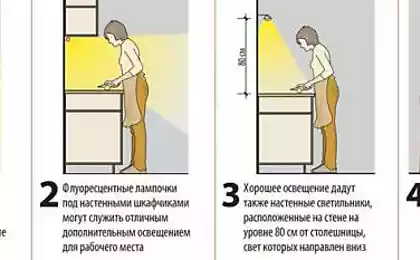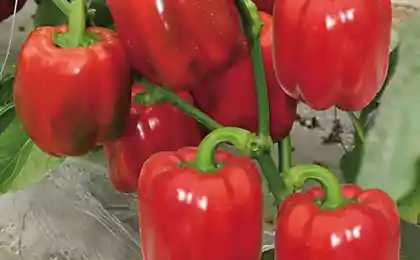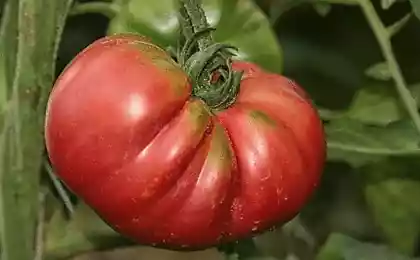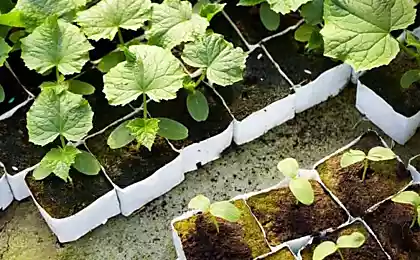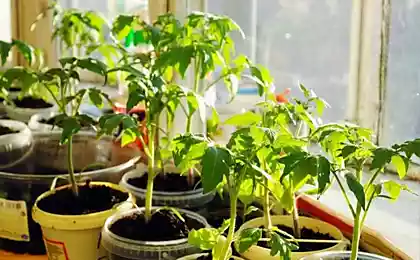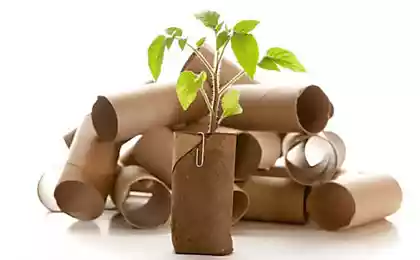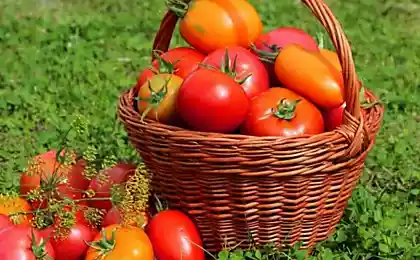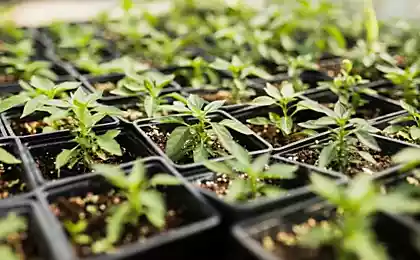149
Elementary illumination for seedlings, so as not to spend extra money, but to get tenacious and powerful sprouts
Many gardeners are looking forward to the end of winter to quickly start working on the beds. On the eve of a new summer season, they dream of growing tenacious and strong seedlings. But the difficulty is that they need to start growing in January-February, when sunlight is catastrophically lacking even on the southern windowsill. Whatever you do, you need lights for seedlings. We will tell you how to replace expensive phytolamps so that seedlings receive everything necessary for its normal growth and development.
306268
For the organization of competent illumination, you need to take into account its duration, intensity and choose the spectral composition of light. As for the duration, it depends on the type of plants grown. Tomatoes need 15 to 17 hours a day. And pepper and eggplants are enough and 11-13.

The optimal light intensity for most plants is within 8,000 lux. But for a healthy seedling, 6000 lux are enough, which is easier to get using inexpensive equipment.
The light flux of a particular spectrum has different effects on seedlings. And the task is to choose the most important components for plants. As a rule, they choose red and blue. The red spectrum accelerates the germination of seeds and promotes vertical growth of seedlings. Blue and purple stimulate the process of photosynthesis, increase the rate of cell division.
At once we will say that none of these lamps can completely replace the sun. They all have their advantages and disadvantages. And the task is to choose the best option, taking into account efficiency, efficiency and usability.
Luminescent is a glass tube covered from the inside with a layer of phosphor, filled with an inert gas and containing a drop of metallic mercury inside. They do not emit heat, are durable, contain some red in the spectrum.

The disadvantages of fluorescent lamps include insufficient power. Even for a small box with seedlings, you will have to install 3-4 lamps, which will lead to tangible energy costs. It should be noted the mercury content, due to which there are increased requirements for their disposal.
Phytolumps View this post on Instagram
Posted by Fitolampa on the pinch (@my_fitolamp)
They also belong to the luminescent category, but are designed specifically for plants, which means they provide an ideal spectrum of light for seedlings. The main disadvantage of phytolamps can be called high cost compared to conventional daylight lamps. Reluctantly lit at low temperatures, and therefore their use in greenhouses for growing cold-resistant crops is difficult.
LED lamps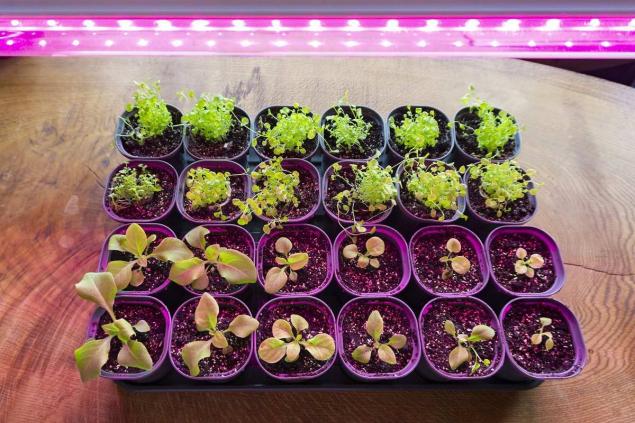
The most modern and promising way to create lighting. LED lamps combine long service life (up to 50,000 hours), environmental friendliness and low power consumption. And most importantly, their advantage is the ability to smoothly regulate the intensity of glow and, combining elements, get uniform light of almost any spectrum.
To assemble an LED phytolamps, you will need the following elements: LEDs of the right spectrum, a case with a reflector (suitable from an old fluorescent lamp), a cooling radiator, a power source, a cord with a fork and switch.
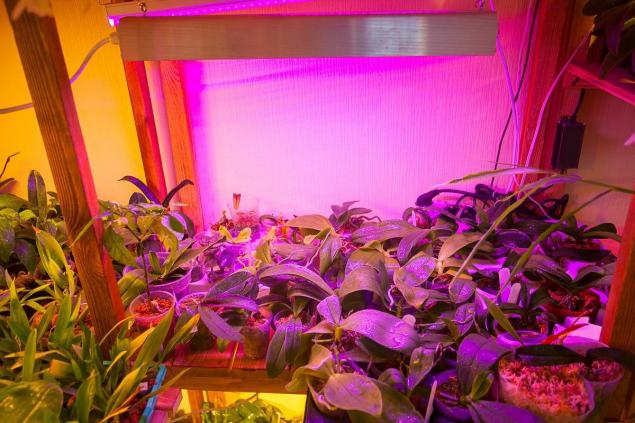
Let's start with LEDs. Today, on sale you can find LEDs with universal blue-red radiation (USCI) for plants. But they're still relatively expensive. Therefore, for budget lighting, it is better to choose simple LED tapes. The required lighting intensity will provide 120 LEDs (2 meters of tape). And for the correct spectrum, blue and red light sources should be used in a ratio of 1 to 3.
As a radiator suitable thin aluminum plate. Tie it to the lamp body and glue the LED tape sliced in parts on top. Then, using a soldering iron, connect all parts of the tape with wires and connect to the power supply. It remains to securely fix all the wires, and you can check the operability of the lamp.
As you can see, for people with technical education or experience in working with electricity, it will not be difficult to collect LED illumination for seedlings with their own hands. But, again, in each case, you need to choose the type of backlight that is best suited. Strong, healthy seedlings and a generous harvest!
306268
For the organization of competent illumination, you need to take into account its duration, intensity and choose the spectral composition of light. As for the duration, it depends on the type of plants grown. Tomatoes need 15 to 17 hours a day. And pepper and eggplants are enough and 11-13.

The optimal light intensity for most plants is within 8,000 lux. But for a healthy seedling, 6000 lux are enough, which is easier to get using inexpensive equipment.
The light flux of a particular spectrum has different effects on seedlings. And the task is to choose the most important components for plants. As a rule, they choose red and blue. The red spectrum accelerates the germination of seeds and promotes vertical growth of seedlings. Blue and purple stimulate the process of photosynthesis, increase the rate of cell division.
At once we will say that none of these lamps can completely replace the sun. They all have their advantages and disadvantages. And the task is to choose the best option, taking into account efficiency, efficiency and usability.
Luminescent is a glass tube covered from the inside with a layer of phosphor, filled with an inert gas and containing a drop of metallic mercury inside. They do not emit heat, are durable, contain some red in the spectrum.

The disadvantages of fluorescent lamps include insufficient power. Even for a small box with seedlings, you will have to install 3-4 lamps, which will lead to tangible energy costs. It should be noted the mercury content, due to which there are increased requirements for their disposal.
Phytolumps View this post on Instagram
Posted by Fitolampa on the pinch (@my_fitolamp)
They also belong to the luminescent category, but are designed specifically for plants, which means they provide an ideal spectrum of light for seedlings. The main disadvantage of phytolamps can be called high cost compared to conventional daylight lamps. Reluctantly lit at low temperatures, and therefore their use in greenhouses for growing cold-resistant crops is difficult.
LED lamps

The most modern and promising way to create lighting. LED lamps combine long service life (up to 50,000 hours), environmental friendliness and low power consumption. And most importantly, their advantage is the ability to smoothly regulate the intensity of glow and, combining elements, get uniform light of almost any spectrum.
To assemble an LED phytolamps, you will need the following elements: LEDs of the right spectrum, a case with a reflector (suitable from an old fluorescent lamp), a cooling radiator, a power source, a cord with a fork and switch.

Let's start with LEDs. Today, on sale you can find LEDs with universal blue-red radiation (USCI) for plants. But they're still relatively expensive. Therefore, for budget lighting, it is better to choose simple LED tapes. The required lighting intensity will provide 120 LEDs (2 meters of tape). And for the correct spectrum, blue and red light sources should be used in a ratio of 1 to 3.
As a radiator suitable thin aluminum plate. Tie it to the lamp body and glue the LED tape sliced in parts on top. Then, using a soldering iron, connect all parts of the tape with wires and connect to the power supply. It remains to securely fix all the wires, and you can check the operability of the lamp.
As you can see, for people with technical education or experience in working with electricity, it will not be difficult to collect LED illumination for seedlings with their own hands. But, again, in each case, you need to choose the type of backlight that is best suited. Strong, healthy seedlings and a generous harvest!
Nutritionist explains on his fingers what you need to replace the meat and butter in your plate
The husband read a note that the whole city knows what his wife is doing, and if he doesn’t believe it, let him know the story of the appearance of a new painting in their house.


